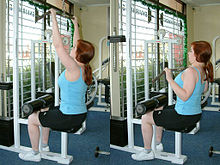Pull-down (exercise)

The pull-down exercise is a strength training exercise designed to develop the latissimus dorsi muscle. It performs the functions of downward rotation and depression of the scapulae combined with adduction and extension of the shoulder joint.
The cable lat pull-down is done where the handle is moved via a cable pulley, as opposed to doing pull-downs on a leverage machine.
Muscles
The standard pull-down motion is a compound movement that requires dynamic work by muscles surrounding the three joints which move during the exercise. These are the
Latissimus dorsi
The
The contraction of these adductor/extensor muscles can indirectly depress and downwardly rotate the scapulae; this is only required when they are pulled into elevation and upward rotation by the contraction of muscles that attach to the scapulae. If the weight were being pulled solely by the lats, for example, the scapulae would simply be pulled down by gravity, along for the ride.
Scapular
Muscles that attach to and depress the scapulae include the lower
Muscles which attach to the scapulae that adduct and extend the arm include the posterior
Elbow
Muscles which flex the elbow joint such as the
A supinated grip at the forearm allows the biceps to contribute more strongly as an elbow flexor. A prone grip will rely more greatly on the other flexors, the brachialis and brachioradialis.
Using a pronated grip during pull-downs tends to result in the greatest activation of the latissimus dorsi, with no difference in latissimus dorsi activity between grip widths.[3]
Similarities
The pull-down is extremely similar to the pull-up, but uses moving external weights or resistance with a fixed body rather than a fixed bar and a moving body. This makes the pull-down an open-chain movement and the pull-up a closed-chain movement. The weight moved can also be adjusted to be more or less than the weight of the person doing the exercise.[4]
Form
The pull-down usually uses a weight machine with a seat and brace for the thighs. The starting position involves sitting at the machine with the thighs braced, back straight and feet flat on the floor. The arms are held overhead at full extension, grasping a bar connected to the weight stack. The movement is initiated by pulling the elbows down and back, lowering the bar to the neck, and completed by returning to the initial position.
Variations
-
Narrow grip underhand pull-down begin
-
Narrow grip underhand pull-down end
-
Narrow grip neutral pull-down begin
-
Narrow grip neutral pull-down end
-
Narrow grip overhand pull-down begin
-
Narrow grip overhand pull-down end
-
Wide grip overhand pull-down begin
-
Wide grip overhand pull-down end
Variations can include touching the bar to the chest (sternum) versus the back of the neck,
The
Behind neck
This variation of the lat pull-down, in which the bar is pulled behind the neck, may be dangerous and less effective.[5] Behind the neck lat pull-downs offer no biomechanical advantages.[6] It can cause compression of the cervical spine disks, and disk damage if contact is made by striking the bar to the neck. In addition, it can cause rotator cuff injuries.[7]
Muscle involvement
If the weight is pulled to touch the front of the chest, the
Etymology
The "lat" sometimes added before "pull-down" commonly refers to the
Most exercises describe the muscle that is involved and the direction of the exercise e.g. biceps curl, triceps extension, leg press, hamstring curl, abdominal curl and so on.
Although "lat" can be first thought as short for "
See also
- Pull-up (exercise)
- Chin-up bar
Notes
- ^ ISBN 978-0-7360-4266-6.
- ^ ExRx explains muscles used
- S2CID 70504128.
- ^ ISBN 978-0-8092-5559-7.)
{{cite book}}: CS1 maint: multiple names: authors list (link - ^ Raffle, Cary. "The Mega List of Exercise Do's and Dont's".
- ^ Anderson, Owen. "Shoulder injury rehabilitation: Which lat pull down variation is best for shoulder injury rehabilitation and shoulder injury prevention?". Archived from the original on 2014-04-07. Retrieved 2012-03-16.
- ^ Duvall, Robert. "Avoiding Shoulder Injury from Resistance Training" (PDF).


